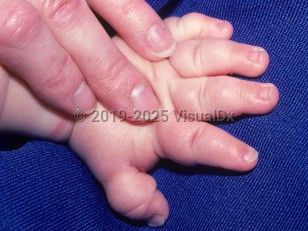Turner syndrome in Adult
Alerts and Notices
Important News & Links
Synopsis

Turner syndrome (gonadal dysgenesis) is a congenital syndrome of females that occurs as a result of partial or total loss of one X chromosome, often secondary to nondisjunction during gametogenesis or a postfertilization mitotic error. Various karyotypes may occur, and a broad array of syndromic findings may be seen.
Skeletal abnormalities include short stature, a broad chest, kyphoscoliosis, a high arched palate and micrognathia, shortened fourth and fifth metacarpals and metatarsals, and Madelung wrist deformity. Characteristic facial features include the presence of epicanthal folds and downslanting lateral canthi. The ears may be abnormally rotated or protruding. There is also an increased incidence of cubitus valgus (a deformity of the elbow with increased carrying angle).
Ovarian dysgenesis leads to primary amenorrhea or secondary amenorrhea, delay of onset of puberty, and infertility. Very rarely, patients with mosaic and even nonmosaic Turner syndrome may become pregnant and may experience complications of pregnancy. Individuals with Turner syndrome who are not diagnosed in childhood are often diagnosed in adolescence due to growth failure and arrested or delayed puberty.
Lymphatic abnormalities include lymphedema and cystic hygroma formation in utero, which may be responsible for the webbed neck (pterygium colli) seen in the syndrome. Lymphedema is prominent in utero and leads to many of the characteristic cutaneous manifestations at birth. Newborns are small for gestational age and have redundant neck skin as well as prominent edema of the hands and feet. Approximately one-third of patients are diagnosed at birth because of the edema. The puffiness of the hands and feet gradually resolves by age 2 years, but it may recur in later life. The nails tend to be hypoplastic, deep set, and the fingernails can be hyperconvex, a result of intrauterine lymphedema. A furrowed scalp, akin to cutis verticis gyrata, is a further sequela of lymphedema. A low-set posterior hairline is a further common feature.
Cardiovascular abnormalities occur in approximately half of affected individuals, and findings include coarctation of the aorta, cystic medial necrosis, bicuspid aortic valve, and hypertension. Sensorineural hearing loss, renal abnormalities (such as horseshoe kidney), and endocrinopathies are further manifestations. Neurocognitive issues, amblyopia, and strabismus have also been reported. Some patients with Turner syndrome have autism traits or meet the diagnostic criteria for autism spectrum disorder (ASD).
Autoimmune conditions including vitiligo, Hashimoto thyroiditis, celiac disease, type 1 diabetes, alopecia areata, inflammatory bowel disease (ie, Crohn disease, ulcerative colitis), and juvenile rheumatoid arthritis are more prevalent in individuals with Turner syndrome.
Related topics: cystic medial necrosis, cystic hygroma
Skeletal abnormalities include short stature, a broad chest, kyphoscoliosis, a high arched palate and micrognathia, shortened fourth and fifth metacarpals and metatarsals, and Madelung wrist deformity. Characteristic facial features include the presence of epicanthal folds and downslanting lateral canthi. The ears may be abnormally rotated or protruding. There is also an increased incidence of cubitus valgus (a deformity of the elbow with increased carrying angle).
Ovarian dysgenesis leads to primary amenorrhea or secondary amenorrhea, delay of onset of puberty, and infertility. Very rarely, patients with mosaic and even nonmosaic Turner syndrome may become pregnant and may experience complications of pregnancy. Individuals with Turner syndrome who are not diagnosed in childhood are often diagnosed in adolescence due to growth failure and arrested or delayed puberty.
Lymphatic abnormalities include lymphedema and cystic hygroma formation in utero, which may be responsible for the webbed neck (pterygium colli) seen in the syndrome. Lymphedema is prominent in utero and leads to many of the characteristic cutaneous manifestations at birth. Newborns are small for gestational age and have redundant neck skin as well as prominent edema of the hands and feet. Approximately one-third of patients are diagnosed at birth because of the edema. The puffiness of the hands and feet gradually resolves by age 2 years, but it may recur in later life. The nails tend to be hypoplastic, deep set, and the fingernails can be hyperconvex, a result of intrauterine lymphedema. A furrowed scalp, akin to cutis verticis gyrata, is a further sequela of lymphedema. A low-set posterior hairline is a further common feature.
Cardiovascular abnormalities occur in approximately half of affected individuals, and findings include coarctation of the aorta, cystic medial necrosis, bicuspid aortic valve, and hypertension. Sensorineural hearing loss, renal abnormalities (such as horseshoe kidney), and endocrinopathies are further manifestations. Neurocognitive issues, amblyopia, and strabismus have also been reported. Some patients with Turner syndrome have autism traits or meet the diagnostic criteria for autism spectrum disorder (ASD).
Autoimmune conditions including vitiligo, Hashimoto thyroiditis, celiac disease, type 1 diabetes, alopecia areata, inflammatory bowel disease (ie, Crohn disease, ulcerative colitis), and juvenile rheumatoid arthritis are more prevalent in individuals with Turner syndrome.
Related topics: cystic medial necrosis, cystic hygroma
Codes
ICD10CM:
Q96.9 – Turner's syndrome, unspecified
SNOMEDCT:
38804009 – Turner syndrome
Q96.9 – Turner's syndrome, unspecified
SNOMEDCT:
38804009 – Turner syndrome
Look For
Subscription Required
Diagnostic Pearls
Subscription Required
Differential Diagnosis & Pitfalls

To perform a comparison, select diagnoses from the classic differential
Subscription Required
Best Tests
Subscription Required
Management Pearls
Subscription Required
Therapy
Subscription Required
References
Subscription Required
Last Reviewed:10/08/2022
Last Updated:05/17/2025
Last Updated:05/17/2025
Turner syndrome in Adult

